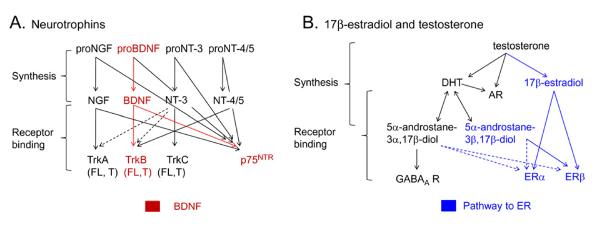Figure 1.

Synthesis and receptors for BDNF, 17β-estradiol, testosterone and their metabolites.
A. The neurotrophin family includes nerve growth factor (NGF), brain-derived neurotrophic factor (BDNF), neurotrophin-3 (NT-3), and neurotrophin-4/5 (NT-4/5). Neurotrophins are produced from precursors (proneurotrophins) which can bind to p75NTR receptors. Mature neurotrophins bind to trk (tropomyosin-related kinase) receptors, which exist in a full-length or truncated form. The truncated receptors lack the intracellular kinase domain of full-length trk. For trkB, there are two truncated forms, trkB.T1 and trkB.T2. Mature neurotrophins can also bind to p75NTR. NGF binds selectively to trkA, BDNF to trkB, NT-3 to trkC, and NT-4/5 is a ligand for trkB. Dotted lines indicate relatively weak binding to receptors.
B. Testosterone binds to androgen receptors (AR) and is the precursor to metabolites acting at estrogen receptors (ER) and androgen receptors (AR). The pathways that lead to ER activation are in blue. DHT= dihydrotestosterone.
